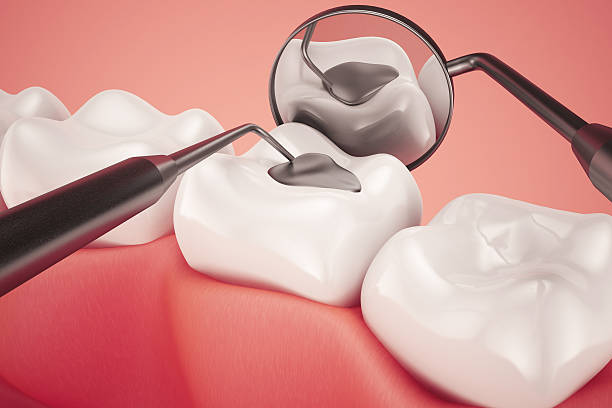
Understanding the Different Types of Tooth Fillings
Introduction
Hi, everyone! You know that saying, “Fixing things early saves a lot of trouble later”? Well, when it comes to taking care of your teeth, it’s absolutely true. Learning about the Different Types of Tooth Fillings might not be as thrilling as watching your favorite TV show, but it’s super important for keeping your smile in top shape. So, grab a small mirror you use for checking your teeth, and let’s talk about dental fillings.
What Are Tooth Fillings, Anyway?
Before we get into the nitty-gritty of the various types of tooth fillings, let’s start with the basics. Tooth fillings, my friends, are like the unsung heroes of the dental world. When your tooth decides to throw a tantrum in the form of a cavity, it’s these little wonders that come to the rescue. They’re designed to fill in the gap left behind by the decayed part of your tooth and prevent further damage.
Now that we’ve got the basics down, it’s time to explore the different types of tooth fillings that your friendly neighborhood dentist might offer.
Amalgam Fillings: The Classic Choice
Amalgam fillings, also known as “silver fillings” (though they contain more than just silver), have been around for eons. They’ve been patching up teeth since your grandma’s grandma’s time. Here’s what you need to know about them:
The Pros
- Durability: Amalgam fillings are tough cookies. They can withstand the test of time, enduring the daily grind of chewing and biting.
- Cost-Effective: If you’re on a budget, these fillings won’t break the bank. They’re the frugal option when it comes to tooth repairs.
- Quick and Easy: Getting an amalgam filling is usually a breeze. Your dentist can pop one in without turning your dental visit into an all-day affair.
The Cons
- Aesthetic Concerns: The silver color can make your filled tooth stand out like a sore thumb, especially if it’s a front tooth. Not exactly the most fashion-forward choice.
- Expansion and Contraction: Amalgam fillings can expand and contract with temperature changes, potentially causing cracks in your tooth over time.
Composite Resin Fillings: The Chameleons of Dentistry
If you’re looking for fillings that blend in seamlessly with your natural teeth, composite resin fillings are where it’s at, my friends.
The Pros
- Aesthetic Appeal: These fillings come in various shades, ensuring they match the color of your teeth like a chameleon in the jungle.
- Bonding Strength: Composite resin fillings bond well with the tooth, providing added support and preventing fractures.
- Versatile: They can be used for both front and back teeth, making them an all-around superstar.
The Cons
- Durability: While they’re pretty sturdy, composite resin fillings might not last as long as amalgam fillings, so you might need a replacement down the line.
- Cost: They can be more expensive than amalgam fillings, but many folks think the aesthetics are worth the price.
Ceramic Fillings: The Porcelain Elegance
If you fancy a touch of elegance in your dental work, ceramic fillings are worth considering.
The Pros
- Aesthetic Brilliance: Like composite resin fillings, ceramics look incredibly natural and are virtually indistinguishable from your real teeth.
- Durability: These fillings are known for their strength and resistance to staining, making them a long-lasting choice.
- Biocompatibility: Ceramic fillings are well-tolerated by the body, making them an excellent option for those with metal allergies.
The Cons
- Cost: The beauty of ceramics comes at a price, and these fillings can be on the higher end of the dental expense spectrum.
- Fragility: They may not be the best choice for molars or teeth subjected to heavy chewing forces, as they can chip or crack.
Glass Ionomer Fillings: The Tooth Saviors for Kids
If you’ve got little ones in the house prone to cavities, glass ionomer fillings are a parent’s best friend.
The Pros
- Release Fluoride: These fillings release fluoride over time, helping to strengthen the surrounding tooth enamel.
- Adhesion: They bond well to the tooth, reducing the risk of leakage and further decay.
- Versatility: Glass ionomer fillings are often used for small fillings and as a temporary solution.
The Cons
- Durability: While they work well for small fillings, they may not be the best choice for larger restorations.
- Aesthetic Concerns: Like amalgam fillings, they aren’t the most aesthetically pleasing option.
Gold Fillings: The Bling of Dentistry
If you’re all about making a statement, gold fillings might just be your jam.
The Pros
- Durability: Gold is the king of durability. These fillings can last for decades without losing their luster.
- Biocompatibility: They’re well-tolerated by the body, reducing the risk of allergic reactions.
- Precision Fit: Gold fillings are often custom-made, ensuring a snug fit in your tooth.
The Cons
- Aesthetic Boldness: Let’s face it, gold fillings are hard to miss. They’re not exactly subtle.
- Cost: The bling factor comes at a price, and gold fillings can be expensive.
Conclusion
There you have it, folks, the lowdown on Understanding the Different Types of Tooth Fillings! Remember, when it comes to choosing the right filling, it’s not a one-size-fits-all deal. It depends on factors like the location of the tooth, your budget, and your aesthetic preferences.
So, the next time you’re faced with a cavity conundrum, you’ll be armed with the knowledge to make an informed decision. Whether you opt for the classic durability of amalgam, the natural look of composite resin, the elegance of ceramics, the kid-friendly glass ionomer, or the bling of gold, just remember to keep those pearly whites shining bright!
Now, go forth and smile, my friends! And don’t forget to give your dentist a high-five for their tooth-filling expertise. Understanding the Different Types of Tooth Fillings has never been this fun, has it?
Leave a reply
